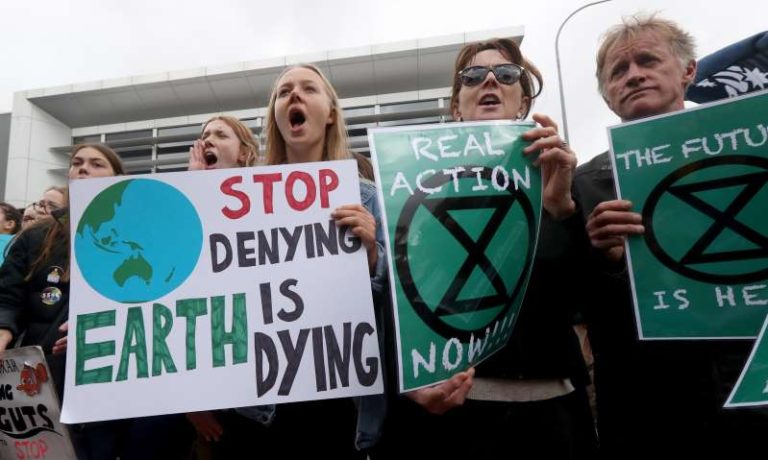Climate crisis is about to put humanity at risk, UN scientists warn

The world’s leading scientists will warn the planet’s life-support systems are approaching a danger zone for humanity when they release the results of the most comprehensive study of life on Earth ever undertaken.
Up to 1m species are at risk of annihilation, many within decades, according to a leaked draft of the global assessment report, which has been compiled over three years by the UN’s leading research body on nature.
The 1,800-page study will show people living today, as well as wildlife and future generations, are at risk unless urgent action is taken to reverse the loss of plants, insects and other creatures on which humanity depends for food, pollination, clean water and a stable climate.
The final wording of the summary for policymakers is being finalised in Paris by a gathering of experts and government representatives before the launch on Monday, but the overall message is already clear, according to Robert Watson, the chair of the Intergovernmental Science-Policy Platform on Biodiversity and Ecosystem Services (IPBES).
“There is no question we are losing biodiversity at a truly unsustainable rate that will affect human wellbeing both for current and future generations,” he said. “We are in trouble if we don’t act, but there are a range of actions that can be taken to protect nature and meet human goals for health and development.”
The authors hope the first global assessment of biodiversity in almost 15 years will push the nature crisis into the global spotlight in the same way climate breakdown has surged up the political agenda since the 1.5C report last year by the UN Intergovernmental Panel on Climate Change.
Like its predecessor, the report is a compilation of reams of academic studies, in this case on subjects ranging from ocean plankton and subterranean bacteria to honey bees and Amazonian botany. Following previous findings on the decimation of wildlife, the overview of the state of the world’s nature is expected to provide evidence that the world is facing a sixth wave of extinction. Unlike the past five, this one is human-driven.
Mike Barrett, WWF’s executive director of conservation and science, said: “All of our ecosystems are in trouble. This is the most comprehensive report on the state of the environment. It irrefutably confirms that nature is in steep decline.”
Barrett said this posed an environmental emergency for humanity, which is threatened by a triple challenge of climate, nature and food production. “There is no time to despair,” he said. “We should be hopeful that we have a window of opportunity to do something about it over these two years.”
The report will sketch out possible future scenarios that will vary depending on the decisions taken by governments, businesses and individuals. The next year and a half is likely to be crucial because world leaders will agree rescue plans for nature and the climate at two big conferences at the end of 2020.
That is when China will host the UN framework convention on biodiversity gathering in Kunming, which will establish new 20-year targets to replace those agreed in Aichi, Japan, in 2010. Soon after, the UN framework convention on climate change will revise Paris agreement commitments at a meeting in either the UK, Italy, Belgium or Turkey.
Watson, a British professor who has headed both of the UN’s leading scientific panels, said the forthcoming report will delve more deeply than anything before into the causes of nature collapse, chief among which is the conversion of forests, wetlands and other wild landscapes into ploughed fields, dam reservoirs and concrete cities. Three-quarters of the world’s land surface has been severely altered, according to the leaked draft. Humanity is also decimating the living systems on which we depend by emitting carbon dioxide and spreading invasive species.
Watson said the authors have learned from attribution science, which has transformed the debate on the climate crisis by showing how much more likely hurricanes, droughts and floods have become as a result of global heating.
The goal is to persuade an audience beyond the usual green NGOs and government departments. “We need to appeal not just to environment ministers, but to those in charge of agriculture, transport and energy because they are the ones responsible for the drivers of biodiversity loss,” he said.
A focus will be to move away from protection of individual species and areas, and to look at systemic drivers of change, including consumption and trade.
The political environment is changing in some countries due to overwhelming scientific evidence and increasing public concern about the twin crises of nature and climate, which have prompted more than 1 million students to strike from school and led to street protests by Extinction Rebellion activists in more than a dozen countries.
The UK parliament declared a climate emergency this week and the government’s chief climate advisory body recommended an accelerated plan to cut carbon emissions to zero by 2050. Until now, however, the nature crisis has been treated as far less of a priority. “Where are the headlines? Where are the emergency meetings?” asked the school strike founder, Greta Thunberg, in a recent tweet on the subject.
Extinction Rebellion activists said protests that blocked several London streets last month were as much aimed at the defence of nature as stabilising the climate. “They are two sides of the same destructive coin,” said Farhana Yamin, a coordinator of the movement who is also an environmental lawyer and formerly a lead author of the IPCC report.
“The work of IPBES is as crucial as the work done by the IPCC on the 1.5-degree report. That is why Extinction Rebellion is demanding an end [to] biodiversity loss and a net-zero phaseout by 2020. We can’t save humanity by only tackling climate change or only caring about biodiversity.”